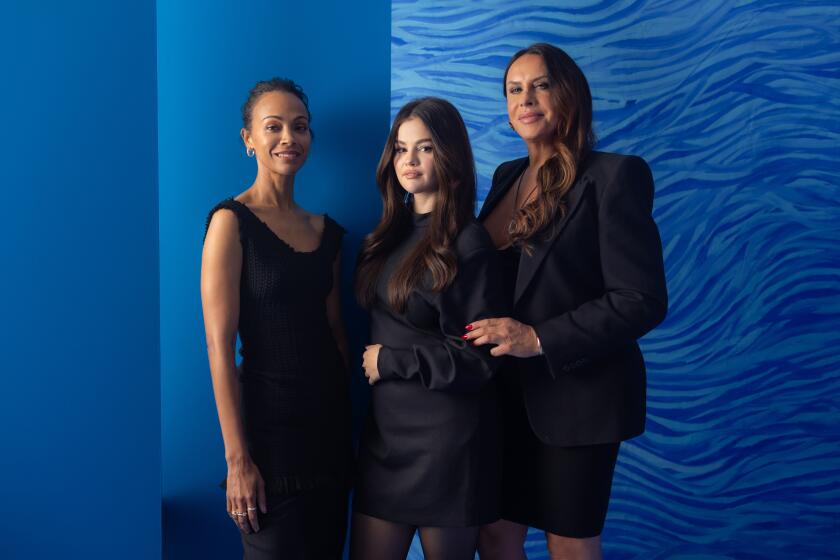Review: Kirsten Johnson’s intimate ‘Cameraperson’ invites a new way of seeing
One of the most nail-biting moments in “Cameraperson,” Kirsten Johnson’s enigmatic yet revelatory new documentary, unfolds in the Bosnian town of Foča, in a remote, scenic valley that was decimated by genocidal violence in the 1990s. The area, as seen through the lens of Johnson’s roving and inquisitive camera, is a killing field no longer; the tension instead derives from the sight of two young boys playing with a sharp ax and a chopping block, with no adult supervision in sight.
If you listen closely, you may hear Johnson mutter “Oh, Jesus” under her breath. Yet she neither intervenes nor stops filming, hewing to the documentary filmmaker’s code of semi-detached observation — a code that “Cameraperson” exists, on one level, to examine and call into question. In ways both subtle and overt, the movie continually draws our attention to the human consciousness guiding every shot, the hand that is gently yet unmistakably manipulating the image.
You may know Johnson’s work from the many documentaries she’s shot over the last two decades, which include Laura Poitras’ “Citizenfour” (2014) and “The Oath” (2010), Ted Braun’s “Darfur Now” (2007), and Kirby Dick and Amy Ziering’s “Derrida” (2002). In this intimate visual collage, she has pulled together snippets and outtakes from those projects and many more, refracting years of professional globe trotting and thorny philosophical reflection through a teasing cinematic hall of mirrors.
The result is at once a career summation, a personal memoir and an uncommonly illuminating blooper reel. It’s also a movie of jarring yet intuitive leaps through time and space. Almost every sequence is absorbing in and of itself, but Johnson’s habit of cutting away after a few minutes or even seconds establishes a gently disruptive rhythm, even as the length and composition of each shot raises its own implicit set of ethical and philosophical questions. It’s her way of telling us to watch closely and think carefully about what we’re seeing, and specifically whose eyes through which we’re seeing it.
When Johnson turns her camera on Guantánamo Bay, we hear her speaking with her collaborators about what she can and can’t photograph; a beat later, there’s a self-censoring shot of a blank wall as she erases some unusable footage. An early discussion of how to film the mosques and minarets in Sarajevo, taking into account such practical considerations as the weather, the lighting and the number of people in each shot, eliminates any doubts about the calculation inherent in her method or the highly personal nature of her art.
Working with editor Nels Bangerter, Johnson arranges her images in splintered yet intuitive fashion. A montage of simple shots of people walking, culled from all over the globe, conveys the shared warmth of an everyday human experience. A ghostly succession of crime scenes — sites of mass imprisonment, torture and murder in Bosnia and Liberia, a car used by white supremacists to drag a black man to his death, the site of the 1890 Wounded Knee massacre — suggests the singular inadequacy of the still image when it comes to capturing the horrors of the past.
Some stories, though not shown consecutively in the film, hang together through visual and compositional echoes. When a Bosnian woman recalls her appalling history of sexual assault, Johnson pointedly keeps her face out of frame, mirroring an earlier scene of a pregnant teenager speaking with counselors at an Alabama health clinic.
In these moments you can sense the filmmaker’s instinctive compassion for her subjects — a compassion that doesn’t recede even when she remains firmly on the periphery of the action, as when she calmly films a Kenyan midwife trying to breathe life and oxygen into an unconscious newborn. In another scene, a boy in Afghanistan calmly recalls the loss of his brother in an explosion that also blinded him in one eye — and Johnson, no less than the viewer, is unable to stifle a natural emotional response.
“I always try to have some kind of relationship with people,” she notes early on. And “Cameraperson” — for all its incursions into past and present war zones, its observation of the universal patterns of suffering and injustice that seem to recur even under vastly disparate circumstances — is above all a richly human document. In the film’s most intimate moments, Johnson lovingly turns the camera on her twin children, her father and her mother (seen here before her death from Alzheimer’s disease). At one point too she even turns the camera on herself — a lovely if somewhat redundant gesture in a work that is already a profound feat of self-scrutiny.
------------
‘Cameraperson’
Unrated
Running time: 1 hour, 42 minutes
Playing: Laemmle’s Royal Theatre, Santa Monica
See the most-read stories in Entertainment this hour »
Movie Trailers
More to Read
Only good movies
Get the Indie Focus newsletter, Mark Olsen's weekly guide to the world of cinema.
You may occasionally receive promotional content from the Los Angeles Times.








